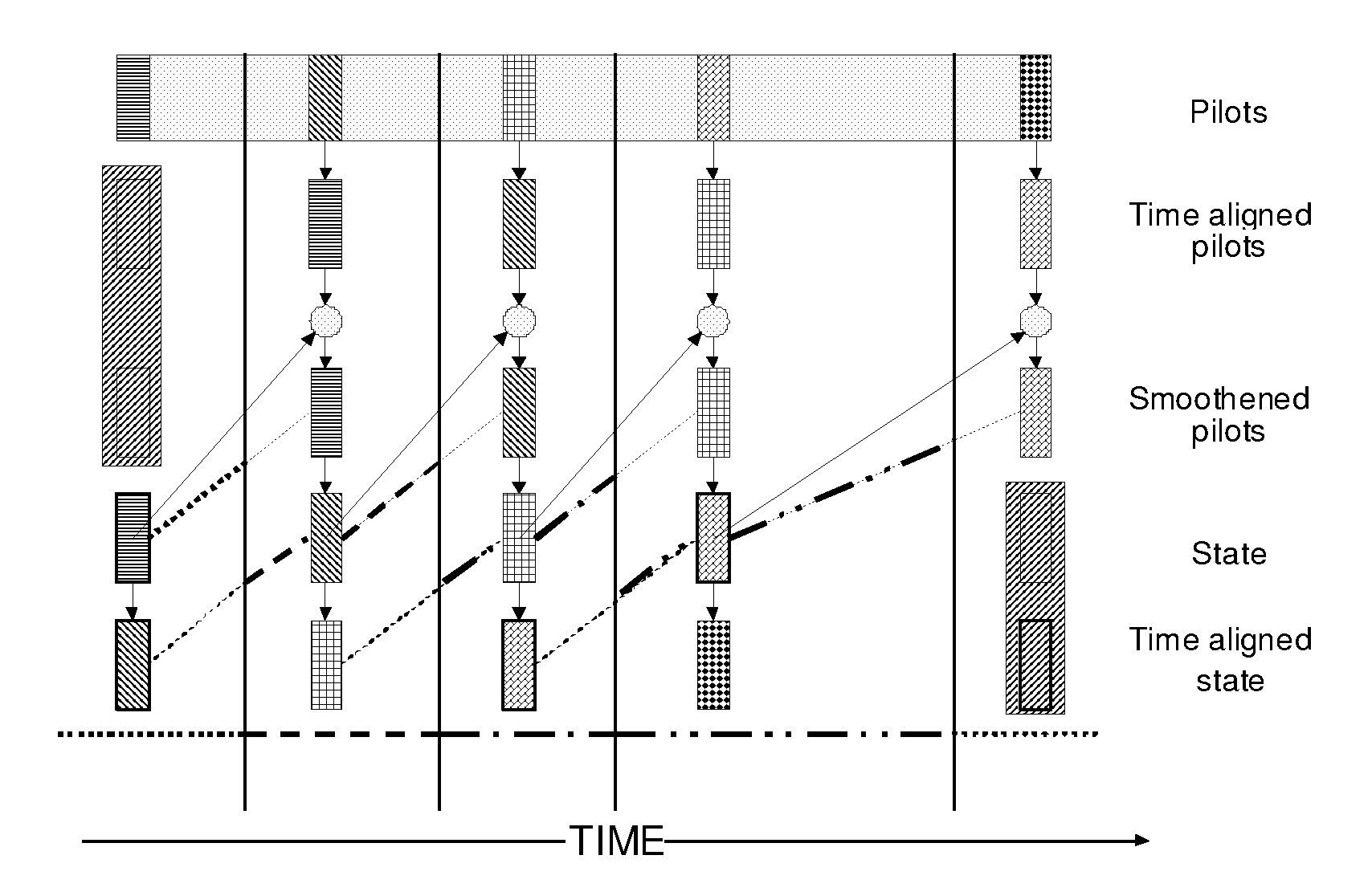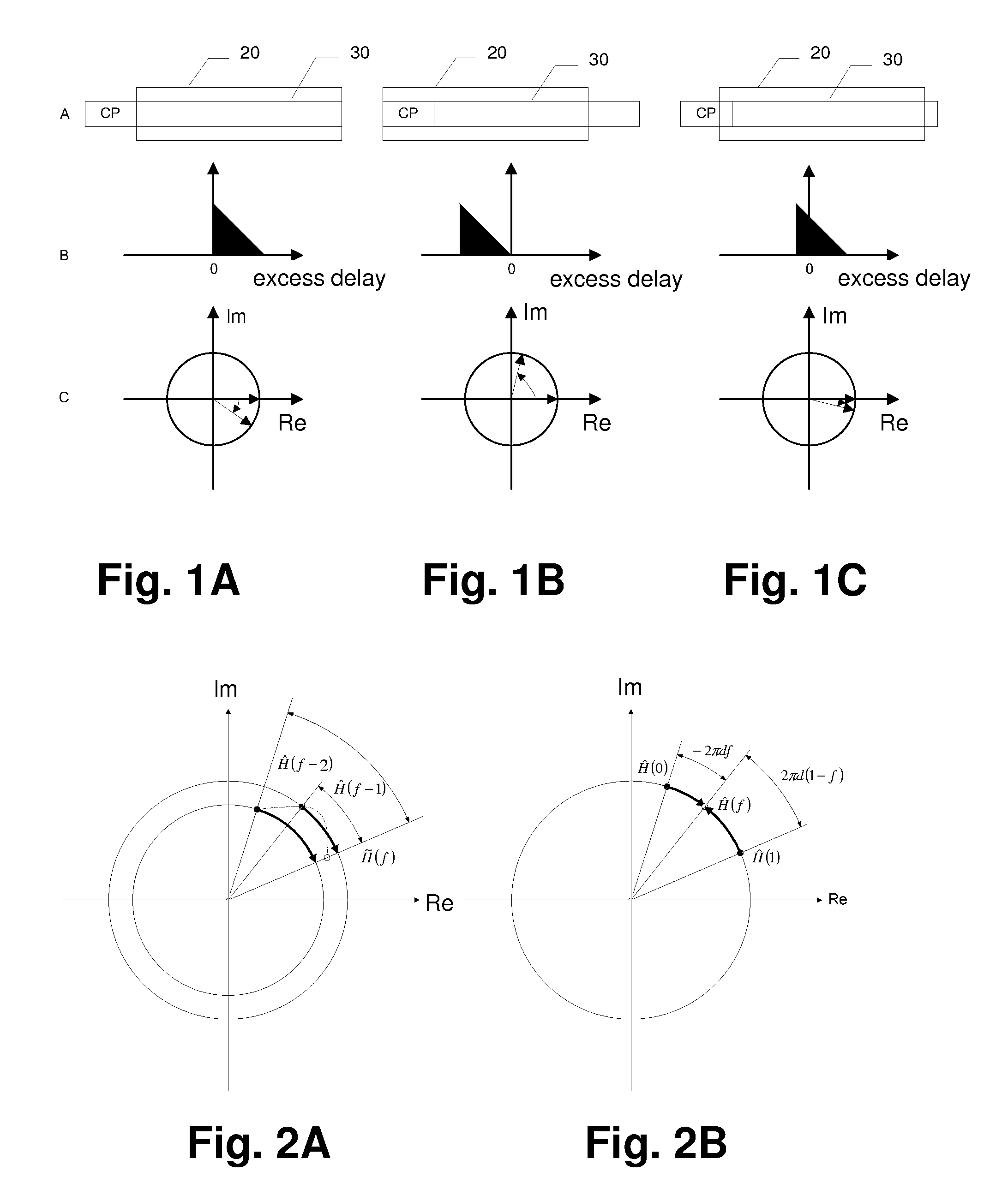Method and apparatus of recursive time-frequency channel estimation
a time-frequency channel and estimation method technology, applied in the field of communication, can solve the problems of high frequency selectivity channel performance, high computational complexity, and the frequency domain smoothing matrix associated with delay (transform) domain channel estimation tend to become computationally intractable to calculate or too large to store for practical purposes
- Summary
- Abstract
- Description
- Claims
- Application Information
AI Technical Summary
Benefits of technology
Problems solved by technology
Method used
Image
Examples
first embodiment
[0071]FIG. 4 shows a schematic block diagram of a receiver part of an OFDM transceiver which can be implemented as a electric circuitry, an integrated chip, a chip set or a receiver module.
[0072]A sampled radio frequency (RF) signal 34 supplied from an RF front end (not shown) is FFT processed in an FFT stage 11 and the FFT processed samples are processed in a pilot estimation (PE) stage 12 to estimate channel values at pilot locations to be used for channel estimation processing in stages 13 to 15. More specifically, the estimated values at the pilot locations are processed in a recursive frequency domain filter stage (RFF) 14 for executing the above described frequency domain processing and then in a recursive time domain filter stage (RTF) 15 for executing the above described time domain processing. Both frequency and time domain filter stages 14, 15 are controlled by a channel adaptation stage 13 configured to adapt the frequency and time domain filter stages 14, 15 to channel ...
second embodiment
[0074]FIG. 5 shows a schematic block diagram of a software-based implementation of the proposed channel estimation mechanism according to a Here, a receiver 30, which may be an integrated chip, a chipset or module, comprises a processing unit 310, which may be any processor or computer device with a control unit which performs control based on software routines of a control program stored in a memory 312. Program code instructions are fetched from the memory 312 and are loaded to the control unit of the processing unit 310 in order to perform the estimation processing steps described above and later in connection with FIGS. 6 and 8. The processing steps may be performed on the basis of input data DI and may generate output data DO, wherein the input data DI may correspond to the RF samples received from the RF front end and the output data DO may correspond to the time-frequency values of the channel estimation result.
third embodiment
[0075]FIG. 6 shows a flow diagram of a channel estimation procedure according to a
[0076]In step S101 a set of noisy CTF samples is obtained from samples at predetermined pilot locations. Then, in step S102, an FFT processing is performed and each processed CTF sample is divided in step S103 by its associated initial pilot value to derive CTF estimates at pilot locations. Then, in step S104, a recursive frequency interpolation (or extrapolation or smoothing) filtering processing is adapted to the channel conditions, as described above. In step S105, a smoothing processing in the frequency domain is executed by using the adapted filtering processing as described above, and in step S106 an interpolation or extrapolation in the frequency domain is executed by using the adapted filtering processing as described above. Subsequently, in step S107, a recursive time interpolation (or extrapolation or smoothing) filtering processing is adapted to the channel conditions, as described above. Th...
PUM
 Login to View More
Login to View More Abstract
Description
Claims
Application Information
 Login to View More
Login to View More - R&D
- Intellectual Property
- Life Sciences
- Materials
- Tech Scout
- Unparalleled Data Quality
- Higher Quality Content
- 60% Fewer Hallucinations
Browse by: Latest US Patents, China's latest patents, Technical Efficacy Thesaurus, Application Domain, Technology Topic, Popular Technical Reports.
© 2025 PatSnap. All rights reserved.Legal|Privacy policy|Modern Slavery Act Transparency Statement|Sitemap|About US| Contact US: help@patsnap.com



